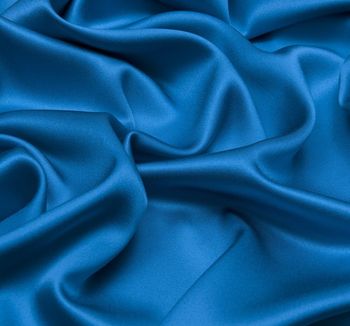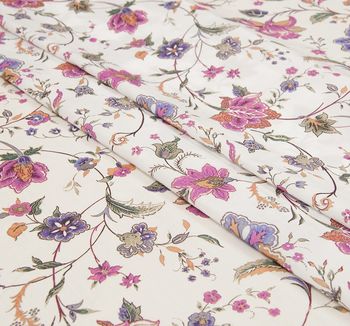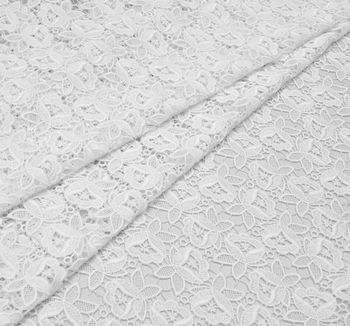Silk is a timelessly trendy natural fabric woven from the cocoons of silk worms. The world’s most famous fashion brands regularly apply it for various men’s and women’s outfits earning the admiration of the audience.
Crepe Fabrics
Crepe fabric is typically a silk or wool cloth which threads are strongly twisted in opposite directions or specifically interlaced. Created of different fibres, it is commonly known for crispy texture and outstanding durability. Crepe weave is applied for a large group of textiles used for various clothing.
Silk crepe fabric is a popular option for evening or bridal dresses, airy summer skirts, scarves and shawls, whereas its wool versions — stretch or double faced — make stylish heavier suits and coats.
What is Crepe?
As we know, crepe creation technology is about strong fibre twisting — up to 3000 times, when a fibre gets the properties of a spring. However, what happens next? How does crepe get all its amazing properties? We bet, even those of you who have never been much into manufacturing technologies, have been curious what makes crepe fabric that classy. At least once. Well, it’s the time to find out all the secrets of crepe fabric production stages.
- The set of fibres to be sewn into crepe fabric is twisted in the left and right directions;
- The twisted threads are interwoven in a traditional plain weave, by alternating the threads twisted in opposite directions;
- The fabric gets boiled. The knots get weaker, partly untie, yet stably remain on the spots of threads interlacing;
- The drying stage. As a result, the fabric with a uniformly grained surface is achieved — it is rough, densely woven, non-wrinkling and non-stretching. Moreover, in the case of silk crepe, such technology retains all the antiseptic properties silk is renowned for.
That technology is not the only existing one, as the stage 2 can vary. For example, the twisting only by the weft, the twisting to only one side or a chaotic alternation of a warp and weft with a versatile filament twist.
Double crepe is renowned for its increased resilience, that's why a skirt made out of such fabric will keep its shape even without a crinoline.
These days, the weave out of twisted fibres is applied not only for silk but also for cotton, wool, viscose, polyester, acryl, etc. In order to cut the price, some manufacturers apply synthetic and artificial fibres in a classic crepe fabric.
Types
As was mentioned above, crepe fabrics come in many types. Before going into details, however, it is important to classify them by the degree of the crepe weave application:
- Crepe fabrics. Both in their warp and weft, the threads of a higher twisting are used. The effect of roughness and grain is expressed to a higher degree.
- Semi-crepe fabrics. The threads of enforced twisting are used only in the weft, while the usual flat twist threads are used in the warp. The grain effect is muted.
|
type |
sort of fibre |
properties |
application |
|---|---|---|---|
|
crepe de chine |
silk |
Lightweight, matt, crepe texture is not expressed clearly |
Evening and bridal gowns, summer clothing |
|
crepe satin |
Silk or man-made fibres |
Lightweight, airy, perfectly drapable, heavy. Glossy satin weave on the face side, matt crepe weave on the back side |
Evening outfits, draperies |
|
crepe chiffon |
Silk or man-made fibres |
Airy, semi-transparent, with expressed relief texture |
Shawls, stoles, pareo, summer skirts |
|
crepe georgette |
Silk or man-made fibres |
Fine, transparent, expressed texture |
Lightweight clothing, scarves and shawls |
|
crepe marocaine |
Silk, wool, viscose |
Repetitive weave, embossed texture |
Suiting fabric |
|
pleated crepe |
Wool or wool blend |
Wrinkle-resistant |
Scarves, shawls, various types of clothing |
|
crepon |
Silk, rayon, wool, wool blend |
Heavier and more rugged than crepe |
Suits, jackets, coats |
Despite crepe is generally perceived as a dressmaking fabric, it would be wrong not to mention its application in home textiles, such as bedclothes or furniture draperies. What makes it favoured in that area?
- Dust-resistant
- Non-absorbent of excessive moisture
- Comes in various colours and tints
- Retains colour saturation for a long time
.jpg)
Properties
Despite the properties of crepe vary across its types, it is still possible to find out some basic ones, common for all of them.
|
Pro |
Contra |
|---|---|
|
Resilience: shape retaining and resistance to wrinkling |
High price on 100% silk crepe |
|
Decent softness |
Crepe satin and crepe chiffon can be easily spoilt by snagging |
|
Resistance to dust and moisture |
Subjected to fraying |
|
Outstanding wear-resistance |
Tough to clean |
|
Variety of colourways: it comes both in pastel and vivid shades |
Silk crepe with inclusions of wool or viscose can be spoilt by a washing machine |
|
Relative airiness |
Non-elasticity |
|
hypoallergenicity |
- |
|
Air permeability |
- |
|
Makes a flowy drape |
- |
Despite the disadvantages, crepe is still one of the most desired fabrics by the leading fashion designers, just as in the 1960s. Today, silk crepe has become less problematic to sew with and use mainly due to the application of man-made fibres.
.jpg)
Where to Buy Crepe Fabrics?
Tissura offers a large collection of silk and wool crepe fabrics by such iconic French and Italian brands as Taroni, Binda, Belinac and Grosber — the brands renowned for their highest craftsmanship in fabric production. Solid and patterned, coming in a widest colour palette, our silk crepe fabrics are the ideal options for stylish and comfy blouses, dresses, skirts and trousers. To give your look a particularly exclusive vibe, go for silk crepe featuring an eye-catchy ombre effect.
Our wool crepe fabrics are subdivided into double-faced, stretch and embroidered types, all coming in a rich colour palette.
- The double-faced ones are the opaque and flexible textiles featuring a slight diagonal stretch and an excellent drape, perfect for stylish jackets, dresses and coats. This type of crepe is woven at the mills of Grosber, a prominent Italian manufacturer of luxury wool;
- Stretch crepe is a thin, crisp and highly durable fabric that features a slight stretch in the weft. Shop for stretch crepe fabrics online at Tissura to bring your outfit an enchanting drape. Just as the previous wool crepe sort, this one comes from Grosber too;
- Embroidered crepe is a unique fabric created for the true fashion connoisseurs by Jakob Schlaepfer. Soft and slightly textured, it is decorated with stylish ladies in hats, which makes it a go-to option for cool weather dresses, skirts and jackets.
We absolutely share the manufacturer’s excitement for launching a new fabrics collection on the market and strive to be the first on the web to offer them. How do we manage to take the lead? Tissura regularly attends the Première Vision fabric exhibition annually organised in Paris and has a chance to connect with the leaders in the textile industry there. The latest trends in design, cutting-edge technologies and the vision of the direction fashion will evolve in the near future — all make the cornerstone values we are inspired by in preparing our crepe fabric collections. Not surprisingly, the term “stock fabrics” is a completely alienating one for Tissura. Headed by that approach, we manage to offer fabrics of not only the current fashion season but of the several seasons to come too.
To get a brief impression of what sort of crepe fabrics you can buy at Tissura online, see the few fabrics below. To enjoy the whole our range, click on the button underneath them.
Silk crepe fabric, 147 € (183 US$) per one running metre
Silk crepe fabric, 147 € (183 US$) per one running metre
Double faced wool crepe fabric, 103 € (128 US$) per one running metre
Stretch wool crepe fabric, 88 € (109 US$) per one running metre
How to stay cool on a hot summer day? Wear fabrics built for the heat. Cotton, linen, viscose, silk – there are dozens of summer-friendly materials you can choose for your wardrobe. The best fabric to opt for when the temperature rises should be breathable and comfortable.
The wedding dress is one of the most important clothing items a woman gets to choose in her lifetime. It can be made of silk or cotton, lace or tulle, be strewn with sequins or embroidered with beads.
.jpg)
.jpg)
.jpg)
.jpg)


